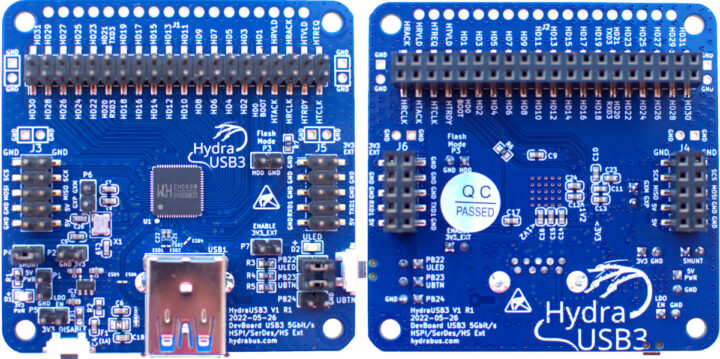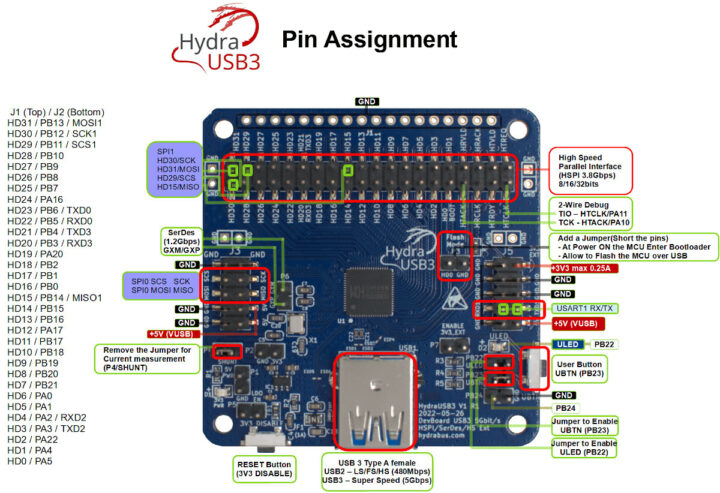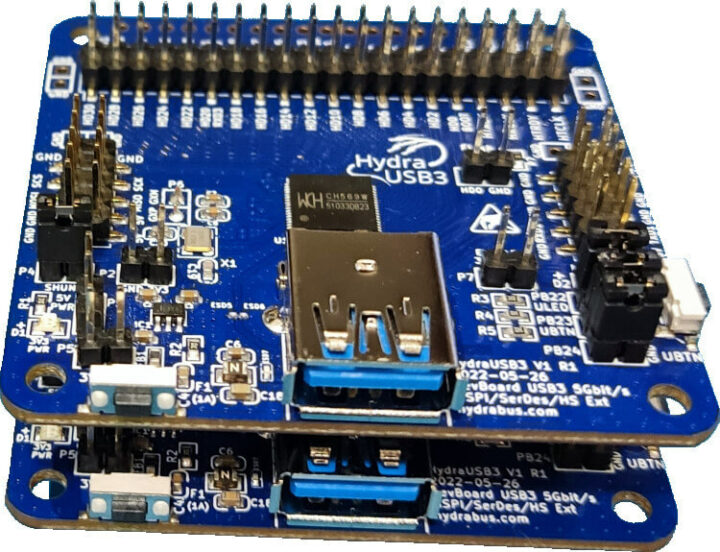Benjamin VERNOUX has launched the HydraUSB3 V1 board based on WCH CH569 RISC-V MCU as a developer platform to experiment with high-speed protocols like HSPI and SerDes through a USB 3.0 interface.
It’s the third board from Benjamin we feature here, after the STM32-based HydraBUS and the HydraNFC v2 shield delivering up to 1600 mW for NFC charging and connectivity. The HydraUSB3 v1 is quite different since it does not involve NFC at all, and instead leverages the CH569’s high-speed interfaces including USB 3.0 (5 Gbps), HSPI (3.8Gbps), and SerDes (>1.2Gbps).
HydraUSB3 V1 specifications:
- MCU – WCH CH569 32-bit RISC-V (RISC-V3A) RV32IMAC MCU @ 120MHz with 16KB 32-bit SRAM, 96KB configurable 128-bit SRAM, 448KB code flash, 32KB data flash
- USB – 1x USB 3.0 host/device port that supports the USB 3.0 SS built-in PHY (5Gbps) and USB 2.0 built-in PHY FS/LS/HS (480Mbps)
- High-speed I/Os
- High-Speed Parallel Interface (HSPI) up to 3.8Gbps with fast bidirectional parallel bus 8, 16 & 32bits up to 120MHz
- 2-pin SerDes up to 1.20Gbps officially, up to 1.38Gbps non-officially
- Other I/Os
- SPI header up to 50 Mbps
- UART header
- Misc – Reset button, user button, user LED, a jumper for current measurement, a jumper for bootloader/flash firmware, etc…
- Power Supply – 5V via USB port
- Dimensions – 60 x 60 mm
Th HydraUSB3 ships with an open-source test firmware that’s available on Github with source code, examples, and libraries (e.g. libusb) to experiment with USB 2.0, USB 3.0, HSPI, SerDes, and of course, the user LED with a blinky sample. The HydraUSB3 has been tested at more than 330MB/s from the board to the PC Host, and more than 250MB/s from the PC Host to the board.
The board can be interfaced with an FGPA to be used as a USB 3.0 to HSPI or SerDes bridge, and two boards can be interfaced to test “ultrafast” communication and transfer of data and experiment with multi-CPU communication with one board configured as a host, and the other a device using the PB24 jumper. For that purpose, the boards are even designed to be stacked.
The HydraUSB3 board is sold on Digikey for $59.99, but Benjamin is also selling a kit with two boards on his online store for 120 Euros. You’ll need a USB 3.0 male-to-male cable that is not included, and extra jumpers are also recommended for configuration as explained on the product page.

Jean-Luc started CNX Software in 2010 as a part-time endeavor, before quitting his job as a software engineering manager, and starting to write daily news, and reviews full time later in 2011.
Support CNX Software! Donate via cryptocurrencies, become a Patron on Patreon, or purchase goods on Amazon or Aliexpress







